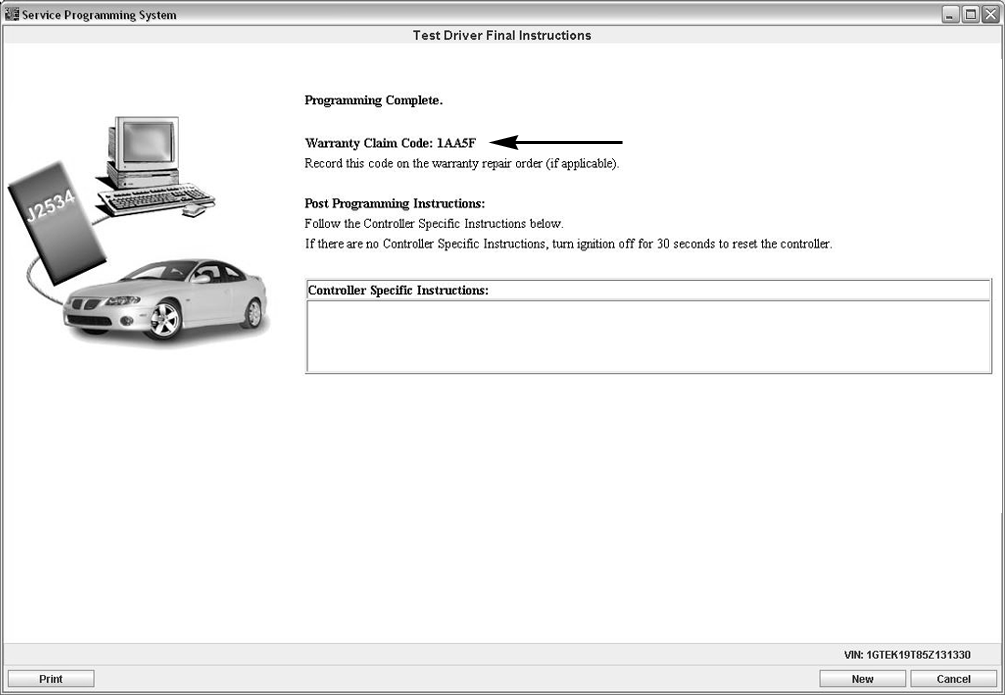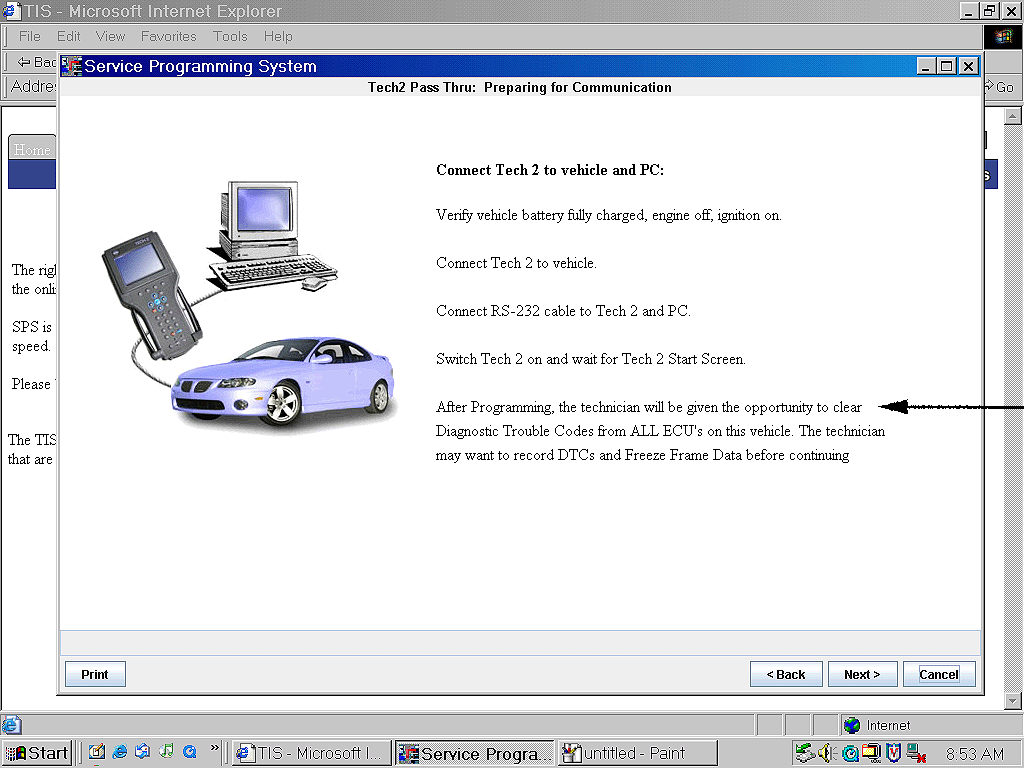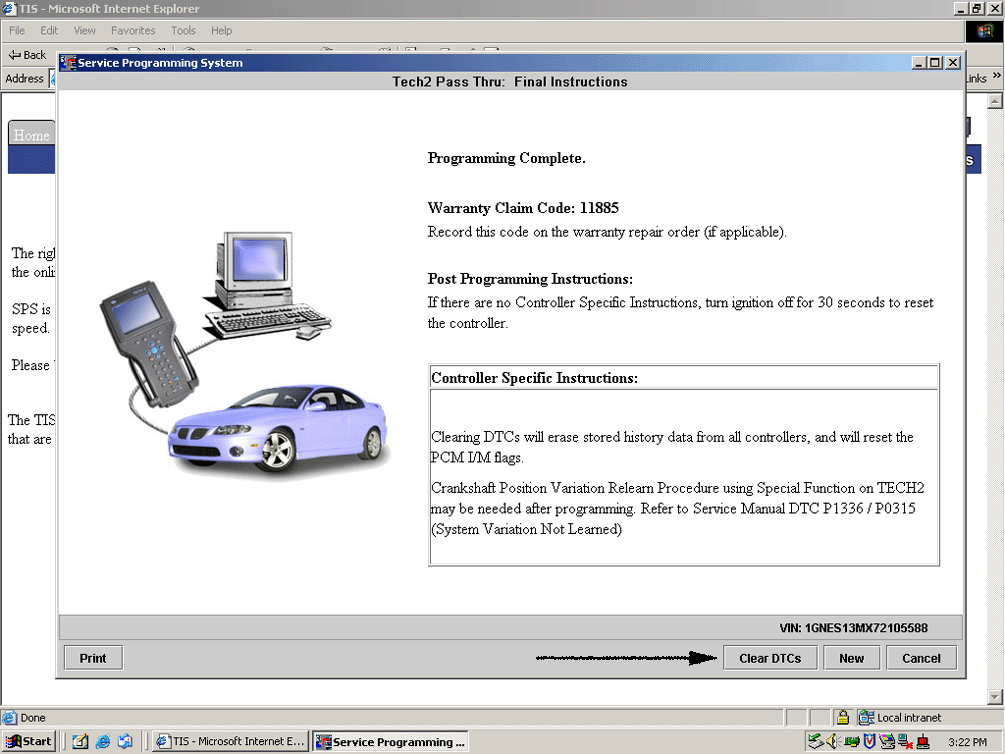Warranty, SPS, Control Module Diagnostics and Configuration Information, Programming, Set-Up

| Subject: | Warranty, SPS, Control Module Diagnostics and Configuration Information, Programming, Set-Up |
| Models: | 2004-2008 Passenger Cars and Light Duty Trucks |
| 2004-2008 HUMMER H2 |
| 2006-2008 HUMMER H3 |
| 2005-2008 Saab 9-7X (Canada Only) |
| 2004-2008 Saturn Vehicles |
This bulletin is being revised to include sequential reprogramming warranty claim code requirements (when it is generated by SPS). Please discard Corporate Bulletin Number 06-08-47-001D (Section 08 -- Body and Accessories).
Module reprogramming labor operations are used to submit warranty claims for reprogramming (without replacement) of a control module with new or updated software and/or calibration files using the TIS Service Programming System (SPS) application. The following labor operation descriptors for the reprogramming labor operations have been revised to specify that they are only to be used for performing the SPS procedure. These labor operations are only applicable for control modules that have valid service software/calibration files released and are not to be used when replacing a module. The module replacement labor operations include the appropriate time for any configuration or programming procedures that are required.
Important:
• Control module replacement labor operations include programming and/or set-up time as appropriate. • When the component is being replaced, reprogramming labor operations are NOT to be used along with the replacement labor operation. • Reprogramming a control module with the same calibration is not considered a valid repair. • On all reprogramming labor operations, a base time (0.4 hr) is allowed. Only the ECM, PCM and TCM are allowed a diagnosis time of 0.0-0.3 hr. When a bulletin is published with a special bulletin-only labor operation, the diagnosis time is not included
unless there are specific diagnostic steps called out in the bulletin. • The reprogramming labor operations may not be applicable to all vehicles. Refer to Labor Time Guide for usage and times.
Warranty Claim Code | Customer Complaint | Description | Op # |
|---|---|---|---|
All | Campaign or Bulletin | If a labor op was included in the bulletin, please use the listed op number. | As Listed |
10, 11 or 12xxx | Engine Related | Powertrain Control Module - Engine Reprogramming with SPS | J6354 |
10, 11 or 12xxx | Engine Related | Driver Motor Generator Power Inverter Module Programming with SPS | N5898 |
10, 11 or 12xxx | Engine Related | Driver Motor Generator Battery Control Module Programming with SPS | N5899 |
10, 11 or 12xxx | Transmission Related | Powertrain Control Module - Transmission Reprogramming with SPS | J6355 |
18xxx | All | Transmission Control Module - Transmission Reprogramming with SPS | K5364 |
1Axxx | All | Transfer Case Module Reprogramming with SPS | K4121 |
28xxx | All | Electronic Brake and/or Traction Control Module Reprogramming with SPS | H2508 |
28xxx | All | MAGNASTEER Reprogramming with SPS | E9760 |
40, 41 or 43xxx | All | Body Control Module Reprogramming with SPS | N4808 |
40, 41 or 43xxx | All | Door Control Module Reprogramming with SPS | N4879 |
40, 41 or 43xxx | All | Serial Data Gateway Module Programming with SPS | N5897 |
60 or 65xxx | All | Instrument Panel Cluster Reprogramming with SPS | N4199 |
97xxx | All | MIN and/or MDN Cellular Communication (OnStar®) Programming with SPS | N4807 |
99xxx | All | HVAC Control Head Module or Assembly Reprogramming with SPS | D4707 |
80xxx | All | Radio - Reprogram with SPS | R0759 |
B0xxx | All | Remote Control Door Lock Receiver (RCDLR), Reprogram with SPS | R4481 |
FCxxx or FDxxx | All | Occasionally a code generated after an SPS programming sequence or other SPS procedure | See LTG or associated Technical Bulletin |
FExxx | All | Vehicle Theft Deterrent procedure | See LTG or associated Technical Bulletin |
Sxxxx or Txxx or Uxxx.. Zxxxx | All | Special SPS Sequential Reprogramming event that generates a warranty claim code | See LTG or associated Technical Bulletin |
Warranty Claim Information
When submitting a warranty claim for any of the above reprogramming labor operations, the Warranty Claim Code from the "Programming Complete" screen that is displayed when the SPS procedure is complete is required to be entered in the Failure Code/OBDII field of the warranty claim. Claims that do not include the Warranty Claim Code in the Failure Code/OBDII field will be subject to audit and subsequent debit. The Warranty Claim Code is only available when using the TIS-2-Web application. The CD or stand-alone version of TIS does not support the Warranty Claim Code.
A generic code of "ZZ999" was assigned for all programming sequences because the SPS application was unable to generate unique codes. The SPS application has been enhanced to generate unique warranty claim codes for programming sequences now. With this update, all reference to using warranty claim code of "ZZ999" has been removed from SPS.
A unique Warranty Claim Code generated by SPS must be submitted on all warranty claims in which the vehicle was sequentially reprogrammed.
Important: After 11/1/07, any claims without the Warranty Claim Code submitted in the Failure Code/OBDII field of the warranty claim will be rejected. It is recommended that a printed copy of the Warranty Claim Code be attached to the repair order.
Important:
• The Warranty Claim Code should be submitted on all warranty claims in which the vehicle was programmed using the TIS-2-Web application. Warranty claims will be eligible for reject/review and/or subsequent debit if the Warranty Claim Code is not included
in the Failure Code/OBDII field of the claim. • U.S. Dealers Only -- Enter DTC information in the Comment field of the warranty claim. • If an R&R procedure requires SPS programming, please add the Warranty Claim Code in the Failure Code/OBDII field for this warranty claim. Use ONLY the replacement labor operation.

Clear All Diagnostic Trouble Code Procedures
The July Techline Information System software release contains an enhancement that will enable the technician to clear any DTCs present from all of the ECUs on the vehicle. There is text added to the setup screen reminding that this feature will be available. Since this function clears any DTCs that are present from all controllers on the vehicle, the technician may want to check for and record DTCs before proceeding with the SPS event.

After programming is complete, the option to clear all DTCs will be presented. The technician should remember that when used, the clear all DTCs command will clear ECM DTCs, meaning that IM flags will be reset.

Other Electrical Labor Only Procedures
There are other electrical procedures that are not associated with a module part replacement and are also not considered reprogramming. The following table provides examples of these procedures and the appropriate handling from a warranty perspective.
Procedure | Description | Warranty Policy |
|---|---|---|
Set-Up | A procedure that configures a Control Module to vehicle-specific content, operating location, etc. This is also known as "bit flipping" or "option configuration". This is done one time as part of a Control Module replacement procedure. | Labor times are included in the Control Module replacement procedure. Additional time for setup or reprogramming is not applicable. |
XM Activation | A procedure that communicates the new radio ID after replacement of Digital Radio Receiver (DRR) to XM to ensure continuation of XM radio service. | Labor times for XM activation are included in the replacement procedures. Additional time is not applicable. |
Learn | A procedure that stores operating ranges, component identifiers, etc. of components or systems. This is also known as "initializing". This is done one time as part of a component or control module replacement or in some instances after a battery disconnect. | Labor times for component or control module replacement and battery disconnect are included in the procedures. Additional time is not applicable. |
Programming | A procedure for loading the operational software or calibration files of a newly installed control module performed using the Service Programming System (SPS) application. | Labor times for module programming are included in replacement procedures. Additional programming time is not applicable. |
Reprogramming | A procedure to update a module with new software or calibration files. This is a labor-only procedure performed using the Service Programming System (SPS) application. | SPS reprogramming labor operations are specifically released as required for the modules and vehicles that have service software/calibration files released in TIS2000. Diagnostic time is applicable if listed in the Labor Time Guide. |
Sequential Programming | A procedure to update more than one module with new software or calibration files in a predefined order or sequence. The sequence is critical to the outcome of the event and is done automatically by the SPS application. | A unique Warranty Claim Code generated by SPS must be submitted. |
Non-SPS Programming/Setup Operations | Some procedures may not produce a warranty claim code when software is downloaded using the Tech 2®. | Labor times for module programming are included in replacement procedures. For a specific repair appropriate labor operations and labor times will be included in the Technical Bulletin or may be allowed using an N9999. |
Tech 2® Recalibration | A procedure for loading updated calibration files to a control module using the Tech 2®. | Labor times for module programming are included in replacement procedures. Additional programming time is not applicable. |
CD Software Update | Some entertainment systems may require a software update that is performed through a special data CD release. This type of software update is infrequent and is communicated via a Technical Bulletin. | Appropriate labor operations and labor times will be included in the Technical Bulletin. |
Personalization | Setting a system configuration that is a customer preference and described in the vehicle owner manual. Examples include door locking preferences, memory seat, radio presets, compass calibration, etc. | Customer vehicle Personalization is not considered a warranty repair. |
Vehicle Maintenance | Procedures that are performed as part of vehicle maintenance procedures such as Oil Life Reset and Tire Pressure Monitor relearn after tire rotation. | Vehicle maintenance procedures are not considered warranty repairs. |
Accessory Configuration | Some GM Accessory installations require SPS reprogramming or set-up procedures. | Procedures associated with the installation of an Accessory are not covered as warranty repairs. |
Diagnostics | As part of service diagnostic procedures, technicians may re-set Diagnostic Trouble Codes (DTCs) or pull fuses or disconnect connectors to reset software in control modules. | Diagnostics are covered as an add condition in the labor operation that is used to repair the vehicle. |
Customer Concern Not Duplicated (CCND) | When a customer complaint cannot be verified by the service technician after duplicating the conditions described by the customer. This may include checking for DTCs and performing system or circuit verification procedures. | The appropriate CCND labor operation should be used. See list below. Comments describing the customer concern should be included with all instances of a CCND labor operation submission. These labor operations may not be used in conjunction with another labor operation for the same customer concern. |
Customer Concern Not Duplicated (CCND) Labor Operations
Labor Operation | Description |
|---|---|
D9995 | Cust Concern Not Duplicated -- Heating and A/C |
F9995 | Cust Concern Not Duplicated -- Axle and Differential |
H9991 | Cust Concern Not Duplicated -- Brakes |
J9991 | Cust Concern Not Duplicated -- Engine Mechanical |
J9992 | Cust Concern Not Duplicated -- Engine Fuel |
J9993 | Cust Concern Not Duplicated -- Engine Electrical |
J9994 | Cust Concern Not Duplicated -- Engine Cooling |
J9995 | Cust Concern Not Duplicated -- Engine Emissions |
K9991 | Cust Concern Not Duplicated -- Manual Clutch Operation |
K9992 | Cust Concern Not Duplicated -- Manual Trans |
K9993 | Cust Concern Not Duplicated -- Transfer Case |
K9995 | Cust Concern Not Duplicated -- Auto Trans |
N9995 | Cust Concern Not Duplicated -- Electrical |
R9995 | Cust Concern Not Duplicated -- Accessories |
Electrical and Powertrain Controls Labor-Only Labor Operations
Two labor operations are to be used to claim for Labor only when addressing Electrical and Powertrain Controls issues. The labor operations are:
N9999 (0.2 hr) -- Electrical Controls -- Labor Only -- (Comment Required - Describing Corrective Action)
J9999 (0.2 hr) -- Powertrain Controls -- Labor Only -- (Comment Required - Describing Corrective Action)
These labor operations should be used only in instances where a repair procedure is performed to a module that does not require that part to be replaced or any other physical repair. They should NOT be used for setting a system configuration that is a customer preference and described in the vehicle Owner Manual. Examples include door locking preferences, memory seat, radio presets, compass calibrations, etc.
Example: A customer brings in their vehicle for the complaint of the remote start not functioning. The BCM was recently replaced at a different dealership. The technician duplicates the complaint and determines that the BCM was not properly configured. The technician enables remote start and corrects the customer's concern.
A warranty claim should be filed using labor operation N9999 and an appropriate comment must be included, i.e. "disconnected memory seat module connector for 30 seconds, then reconnected."
| • | For U.S. Dealers -- the comment must be entered in the Comment field of the warranty claim. |
| • | For Canadian Dealers -- the comment must be documented on the repair order. |
As in the above example, N9999 and J9999 should be used anytime any module has encountered a software "anomaly" in which the corrective action is to "reset" the module by disconnecting power to the module.
Also, N9999 and J9999 should be used in instances when it is discovered that previous repairs made at a different dealer, have included a replacement of a particular module and the set-up of that module was not completed.
When submitting N9999 or J9999, a full detail comment describing the corrective action that was performed, is required in the Comment portion of the claim for U.S. dealers or documented on the repair order for Canadian dealers. Claims that do not include an appropriate comment will be subject to audit and subsequent debit.
These labor operations may NOT be used in conjunction with another labor operation for the same customer concern.
